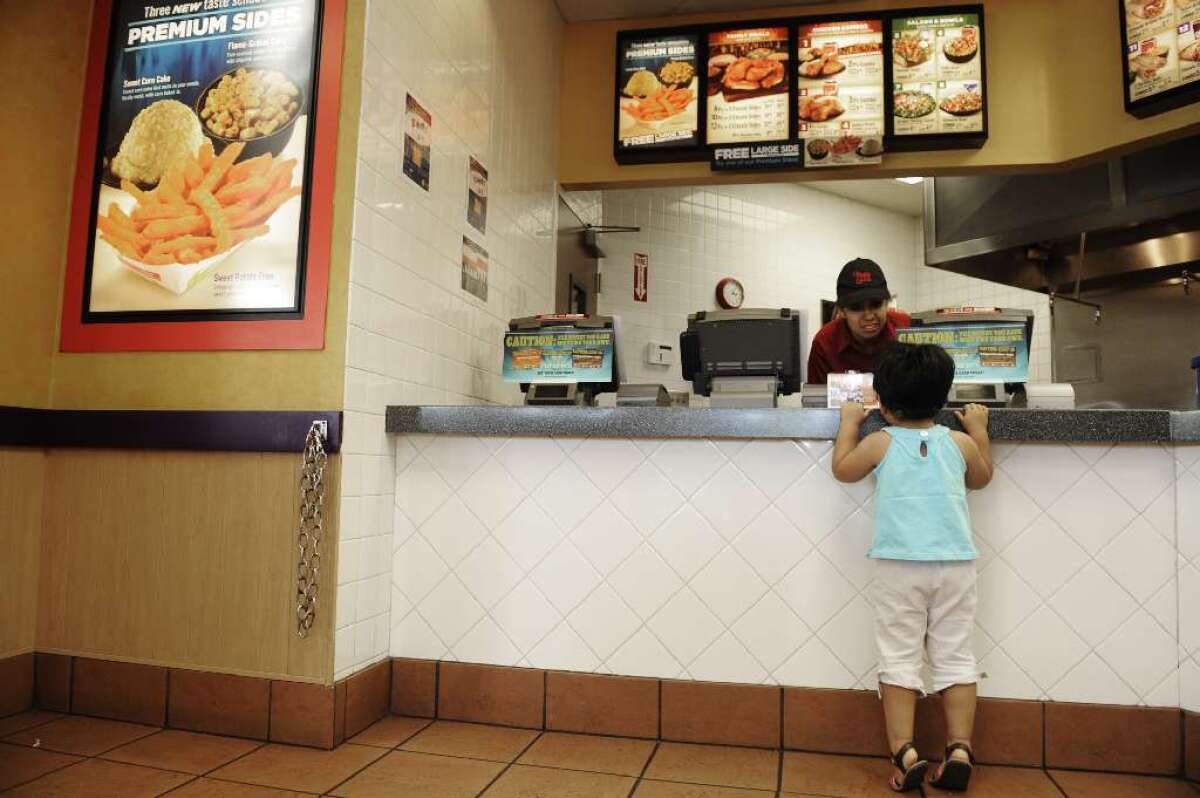CDC reveals just how much fast food American kids eat each day

One-third of U.S. kids eat fast food on a typical day, according to a new report from the Centers for Disease Control and Prevention. Above, a little girl requests a packet of sauce at an El Pollo Loco restaurant in Santa Ana.
- Share via
More than one in three American kids will eat fast food today, a new government report says.
The same will be true tomorrow, and the next day, and the day after that.
On any given day, 34.3% of U.S. children and teens between the ages of 2 and 19 eats pizza, fried chicken, tacos or some other dish prepared in a fast-food restaurant, according to data collected by the Centers for Disease Control and Prevention.
More specifically, 12.1% of these young diners will get more than 40% of their daily calories in the form of fast food. An additional 10.7% will trace 25% to 40% of their daily calories to a fast-food joint, and 11.6% will get fewer than 25% of their calories from one of these dining establishments.
When you average it all out, the youth of America get 12.4% of their calories on a bun, out of a deep fryer or from another quintessentially fast-food source every single day.
It doesn’t matter if these diners are boys or girls. Whether toddlers or teenagers, the proportion of daily calories obtained from fast food was statistically equivalent for both genders, according to the report published Tuesday by the CDC’s National Center for Health Statistics.
Nor did it matter whether diners were rich or poor. Kids from families who were close to the poverty line counted on fast food for 11.5% of their daily calories, on average. Kids at the other end of the economic spectrum averaged 13% of their daily calories from fast food. That gap wasn’t big enough to be considered statistically significant, the report said.
Even weight status had little bearing on the appetite for fast food. Children and teens who were underweight or had a normal weight averaged 12.2% of their daily calories in the form of fast food. That was slightly higher than the 11.6% for overweight kids and slightly lower than the 14.6% for obese kids. Again, those differences weren’t big enough for the researchers to say they were real.
There was a significant difference in fast-food consumption according to race and ethnicity. Asian American kids averaged fewer calories from fast food than their peers, getting only 8% on any given day, on average. That compared with 11.2% for Latino kids, 13.1% for white kids and 13.9% for African American kids. (The differences among non-Asian kids weren’t statistically significant.)
------------
FOR THE RECORD
Sept. 18, 3:18 p.m.: An earlier version of this story said Asian American children and teens were less likely than their peers to eat fast food on any given day, instead of saying that they averaged fewer daily calories in the form of fast food. It also said younger children were less likely than teens to eat fast food on a typical day, instead of saying that fast food accounted for fewer of their daily calories.
------------
The researchers speculated that fast food hadn’t caught on as much in Asian American households because these families weren’t as assimilated into the U.S. lifestyle, including its eating habits. Fully 27.4% of Asian children in the United States were born overseas, compared with 19.7% of Latino children, 2.5% of whites and 1.9% of blacks.
The other significant difference had to do with age. Overall, children between the ages of 2 and 11 ate less fast food than adolescents between the ages of 12 and 19. On a typical day, fast food accounted for 8.7% of the calories eaten by younger kids, compared with 16.9% for older children. That pattern was seen regardless of gender, race or ethnicity, weight status or family income, the researchers found.
The report was based on data from the CDC’s 2011-2012 National Health and Nutrition Examination Survey.
Follow me on Twitter @LATkarenkaplan and “like” Los Angeles Times Science & Health on Facebook.
ALSO:
South L.A. ban on new fast-food restaurants has little effect
On antibiotics fast-food report card, Panera, Chipotle get an A grade
Fast-food nation? Where you live doesn’t affect what you eat, researchers say






